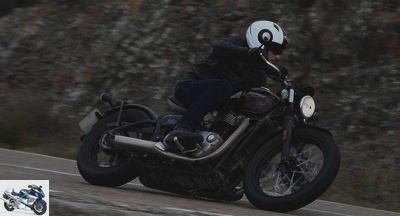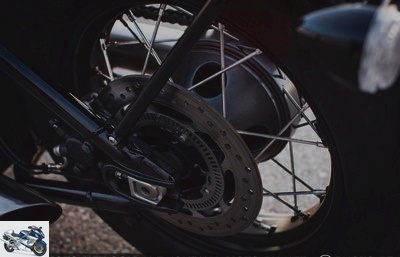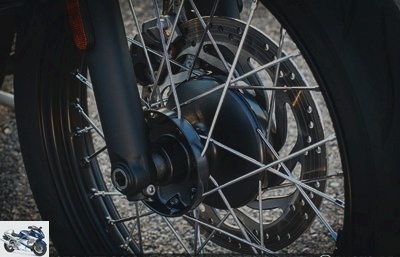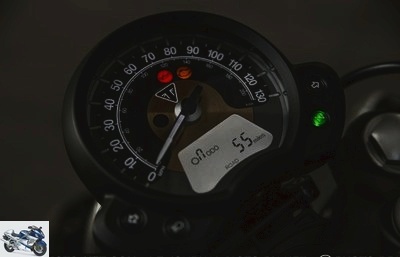Triumph Bonneville Bobber test: the butter and the money of the beau-bber !

Beautiful, chic and charismatic, the Triumph Bonneville Bobber daringly dust off a genre captured by Harley-Davidson. But the Englishwoman goes far beyond the exercise of style: her dynamic behavior is also in unison with her inspired line.. Well done! First try.
Page 3 – Technical update MNC Bonneville Bobber 2017
Engine
The Bobber uses the 1200cc parallel twin of the Bonneville T120, set at 270 ° and liquid cooled. This Euro4-compliant engine retains the same dimensions (97.6 x 80 mm), the same compression ratio (10 to 1) and the same distribution with single overhead camshaft for the 8 valves. The six-speed gearbox and the final chain transmission are also renewed identically, with no change of gear or reduction..

The differences with the Bonnie block lie exclusively in the intake, exhaust and injection, which remains cleverly camouflaged under dummy carburetors. This injection controlled by an electronic Ride-by-wire accelerator is specific to the Bobber, with a mapping developed to enhance low-revs.
Likewise, the air intake takes a new path, provided by two air boxes placed just below the saddle. These boxes each have their own filter: this unusual technical choice would favor the sound compared to a single larger volume air box, the Triumph engineers explained to us. It is clear that the Bobber has superb vocalizations !

This soundtrack is also well served by two superb brushed stainless steel silencers, both shorter and lighter than those of the T120. All these small changes result in a small drop in power: from 80 hp at 6550 rpm on the T120, it goes to 77 hp at 6100 rpm on the Bobber.
The couple took the opportunity to gain a small newton-meter (106 Nm instead of 105), picked up a bit higher: at 4000 rpm, against 3100 rpm on the Bonneville T120. This detail may be surprising insofar as Triumph announces precisely that it has boosted the low and mid-revs! In reality, this small increase in the torque value hides a significant optimization of the engine filling. As a result, the Bobber would deliver "10% more torque and power" at 4500 rpm than the Bonneville T120.

As on the Bonneville T120, the clutch is of the multi-disc type in an oil bath and is assisted by an anti-dribble device which limits the blockages of the rear wheel when downshifting while reducing the effort required for the lever to disengage. . Finally, the service intervals for this 1200 "High Torque" – as opposed to the "High Performance" fitted on the Thruxton R – are set at 16,000 km, as on the T120.
Part-cycle
As for the engine, the Bobber frame is taken from the Bonneville T120: it is a frame made of steel tubes, of the cradle type. On the other hand, the whole minimalist rear part – directly inspired by the motorcycles of the 40s – is completely new. Note that this tubular frame has no support to accommodate a possible passenger saddle: the Bobber is approved as a strict single-seater motorcycle and cannot be modified..

The dimensions of the chassis are also deeply modified, in particular at the level of the wheelbase which passes from 1445 mm to 1510 mm, or 65 mm. In a very relevant way, Triumph has avoided the traps set by this large wheelbase by limiting the opening of the front axle: thus, the caster angle increases only by 0.3 ° compared to the T120 (25 ° 8 against 25 ° 5) while the frame even decreases by 17.9 mm to maintain maneuverability (87.9 mm against 105.2 mm on the T120).
Bobber style obliges, the size of the wheels increases to 19 inches and the rear to 16, against 18 and 17 respectively on the Bonneville T120. On the other hand, the width of the tires is extended to 100 mm at the front and 150 at the rear, again so as not to deteriorate the handling of the motorcycle with a front tire that is too wide as is practiced in the category (often in 130 mm).
In the same vein, Triumph worked with tire specialist Avon to develop a unique rear tire with a radial structure. "This tire weighs a kilo less than its equivalents with a diagonal structure. It’s as many less suspended masses and that’s good for the dynamism of the bike, which was our priority", reveals Felipe Lopez, the very friendly and fast engineer and development pilot of Hinckley motorcycles.

By the way, it is also the first radial rear tire of this size in the category. Note that the valves of these tires are not bent: we console ourselves with their superb hubs radiated rims, which evoke drums of yesteryear. Another first on the Bobber: its single-seater saddle has the particularity of being adjustable. Changing the position requires first of all to unscrew a screw located at the base of the tiny 9.1 l (14.5 l on the T120) tank to tilt the saddle upwards..
In this way, you gain access to the two nuts that hold the saddle on its metal support. Once these nuts are unscrewed, the seat can move back "approximately 30 mm" according to Triumph, which lowers it slightly at the same time (690 mm in the low position, against 785 for the T120!). The position then becomes more curled up, the bust substantially tilted on the handlebars. Logically, the arms are also more stretched and the legs are more bent. To take care of the custom style, it’s nice but in terms of comfort, you will have to iron…
Another downside: the key necessary to loosen these famous fixing nuts is not provided in the tool behavior located behind the right side of the fairing! This small space only includes a flat and Phillips screwdriver and a tool to unscrew the metal cap of the coolant reservoir, in order to top up. Clearly, you determine your position once and for all in the garage, but not while driving.

The braking system, supplied by Nissin, is taken from the Bonneville T120, with one important exception: the front has only one disc to promote the look, there the Bonnie has two 310 mm at the before. This single disc retains the T120’s two-piston caliper, as does the 255mm disc at the rear, which is bitten by a single-piston caliper. Everything is supported by a Continental ABS, which cannot be deactivated.
The suspensions from Kayaba are completely revised for the Bobber, with first of all a notable shortening of the travel especially concentrated on the rear: from 120 mm front-rear on the T120, this goes to 90 mm and 77 on the Bobber! Comfort is not however sacrificed so much thanks to the excellent work carried out by the mono-shock absorber mounted on rods. Fixed almost horizontally under the saddle, this shock absorber is not adjustable, nor is the new 41 mm fork..
As a result of these numerous changes, the weight of the Hinckley Bobber climbs to 228 kg dry, which is 4 kg more than the T120 despite the significant reduction in the volume of the tank (from 14.5 l on the T120 to 9.1 ). Like what, turning a place on a motorcycle does not save much weight !
Electronics, piloting aids
Despite its old look, the Bobber conceals advanced technologies, taken as is from the Bonneville T120. This starts with its Rid-by-wire electronic accelerator which controls two injection maps: Rain (rain) and Road (Road). Switching from one to the other is done by driving from the "M" button on the right stalk, then the change must be validated by disengaging.

Non-adjustable but disconnectable traction control is also part of the game. It can only be deactivated when stationary, with the dedicated command on the left stalk. An uncoupled ABS from Continental manages any wheel locks when braking.

Finally, the instrumentation – adjustable in inclination – includes a large needle dial that provides information on the speed, while a digital screen located just below reveals the time, total mileage, two trips, engine speed, gear. engaged, range, instantaneous and average consumption or even mileage before the next service. This complete dashboard – especially in this category – also has the luxury of offering remote controls on the handlebars: the top !

Related articles
-
Triumph Speedmaster test: on the road again, again The Speedmaster is back in 2018 at Triumph, in a brand new version … very close to the Bobber Black…
-
Triumph Bonneville Bobber test: the butter and the money of the beau-bber ! Beautiful, chic and charismatic, the Triumph Bonneville Bobber daringly dust…
-
Triumph Bonneville Bobber test: the butter and the money of the beau-bber ! Beautiful, chic and charismatic, the Triumph Bonneville Bobber daringly dust…
-
Triumph Bonneville Bobber test: the butter and the money of the beau-bber ! Beautiful, chic and charismatic, the Triumph Bonneville Bobber daringly dust…
-
Triumph Speedmaster test: on the road again, again The Speedmaster is back in 2018 at Triumph, in a brand new version … very close to the Bobber Black…
-
Test Triumph Tiger 1200 XRT and XCA 2018: ready for the road adventure Electric window, keyless start, hill start assistant, directional lights,…
-
Cruisers from Harley-Davidson, Moto Guzzi and Triumph Two-cylinder cruiser in the test Aside from galactic performance racers, knees on the ground and…
-
Roadster – Test Yamaha MT-09 2017: mult (r) iples pleasures! – Page 3 – Technical point MT-09 2017
2017 Yamaha MT-09 review: mult (r) iples pleasures ! Having become a bestseller in just four years, the Yamaha MT-09 is full of positive developments for…
-
2017 Suzuki GSX- R1000R review: the beauty of Gex Driven by the most recent hypersport motorcycles for lack of developments in the last ten years or so,…
-
2017 Kawasaki Z1000SX review: a super bike for the road Kawasaki is taking advantage of the changeover to Euro 4 to refine its Z1000SX on many fronts:…